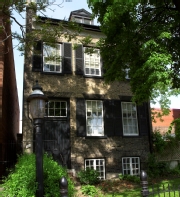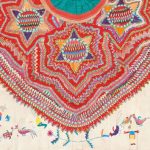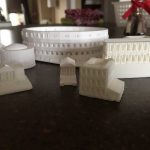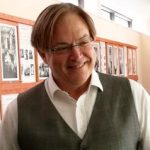
Editor’s note:
DOING HISTORY will be a regular feature of the Rapport Blog. Doing History features profiles of and interviews with people who work in history, not necessarily as history teachers. Posts can be shown to students for career ideas in history and social science! If you know someone that Risa should interview, please email her risa@cabal.org
I meet Bruce Beaton at Mackenzie House in Toronto, the home of William Lyon Mackenzie, leader of the 1837 Rebellion. We are sitting in the day room, a medium-size room with a well worn wooden dining table and chairs, and an unlit fire place, located just off the kitchen. Bruce says this is where the family would have spent most of their time. It is 4:00 pm, so there’s still some light but it’s getting dimmer.
Bruce Beaton is a museum educator. What makes him so fascinating is that he’s also an actor, director, and writer. Bruce has great passion for learning – this comes across immediately when you meet him. He speaks eloquently and with beautiful diction, reflecting the Victorian era that Mackenzie House hails from. On student tours, he says, “we enliven history.” What a beautiful expression – makes me jealous of his job.
I asked Bruce, a museum studies grad, what a museum studies program entails: “learning to make museums better,” he said. Given that it’s a profession that requires both interpretation and creation, it is no surprise that he came to it through history-based theatre work. He also went into the field because he was curious about Mackenzie which lead to him writing a play for Summerworks, a theatre festival in Toronto.
Given his enthusiasm it comes as no surprise that Bruce likes to put the students in the drama. At Mackenzie House they take on roles such as Upper Canadian farmers who must choose whether to support the rebellion or not. Others may act as editor for a day of Mary Ann Shadd’s abolitionist newspaper, The Provincial Freeman (printed on the 170-year old printing press).
I was curious how a museum educator, especially someone who often portrays a role, approaches the issue of perspectives. In history classes we are careful to identify multiple perspectives, not necessarily voice one perspective. Bruce admits that there’s a bias – he is, after all, working in Mackenzie House and sometimes he is Mackenzie. However, other perspectives make their appearances in the tours as well; on tours outside of the museum he includes the view of loyalists; upon the execution of rebels, loyalists sang songs. The tours include these songs. Being so knowledgeable about Mackenzie, he adds that when he returned from the United States years after the failed rebellion, he was received with riots against him in which he was burnt in effigy. Quite interestingly, escaped slaves in Upper Canada did not want anything to do with radical Mackenzie because they feared the reintroduction of slavery if Upper Canada were to become a republic like the US.
When discussing how much background knowledge students bring with them to the museum, he says he starts with this question for students at the Black Press sessions (referring to the work of abolitionist journalist Mary Ann Shadd): “were there slaves in Toronto?” He says it catches some students off guard. When asked if Canadians are a bit smug about their history compared to America with its long history of slavery, Bruce says “there’s a difference between not having slavery and not having racism.”
Bruce Beaton’s work is not limited to Mackenzie. He is also heavily invested in the topic of World War One. A current project he’s working on is a hands-on inquiry in the form of a travelling kit. Amazingly, he comes with the kit when it goes out to schools. With contents from the City of Toronto collection, the kits allow students to touch and feel artifacts. Bruce guides them through analysis, asking them: “What are you curious about? What do you want to know? Where does the story fit with World War One?” This one is trickier: “What does this war mean to you?” He tries to establish relevance for 15-year-olds: statistically, 78% of eligible males tried to enlist. Their keenness was tangible. With 30 kids sitting in front of him, he can show them the math by saying about three of four of them would have enlisted. This is a clever way to convey a foreign concept to today’s teens.
Teenaged Bruce Beaton attended Vincent Massey CI in Etobicoke. He says he doesn’t remember much, except Mr. Pinnel, who on the first day of school pulled out a quarter and talked about how people a thousand years from now would interpret Canadians based on this object: we spoke Latin and we had a pagan attachment to our moose. Sounds like this may have had a profound impact on Bruce’s love for interpretation.
Most of history in high school, he says, he couldn’t relate to. That’s probably why he doesn’t remember it. That leads him to the World War One inquiry – he plays music from the time – it’s so different from today’s music but the kids can relate to the love for music. “Continuity and change,” he muses.
Another interest of Bruce’s is oral history. He’s a member of the Kensington Market Historical Society. The organization began as a concerned group of citizens who wanted to preserve the market as the world changed. He came in a bit later. Now he seeks to preserve and communicate the stories through an oral history project – we “interview folks” as he puts it. Oral history is different – it’s primary source, it’s social history, it’s everyday stuff.
Kensington is both changing and resisting change by seeking heritage designation. When it becomes the desirable part of town, Bruce says, “it’s done.” It exists because it’s affordable. Rents are going up now. He lives there and says it still has an edge and there’s still a wide variety of people, but he now sees more expensive cars parked on the narrow streets. What he really likes is when shop owners work in their own stores. He sees less of it these days. But the market, his home, is still a “salad.”
Is Kensington the paragon of multiculturalism it’s often portrayed as? Bruce reveals that conflicts come out in oral histories. After all, Kensington was, at an earlier stage in its life, an enclave of Jews who felt excluded from Toronto society. It’s a fiercely independent place, not conformist. Doesn’t that sound a lot like Bruce’s beloved Mackenzie?
Another of Bruce’s accomplishments is authorship of an adult colouring book on Kensington – United Colours of Kensington. He wrote the rhyming couplet text. He particularly likes that the last third of the book is for creative drawings, not just filling in the lines – really reflective of Bruce’s creativity.
I had to ask Bruce of any fears about living in the age of Trump. He says it’s tempting to say we live in the post-truth age. But, his experience is more positive. He sees people bring their curiosity to Mackenzie House – they want truth. He never sees negative reactions as people are genuinely curious. “So maybe curiosity will save us? ” he both ponders and posits. He is not experiencing the denial of history that is prophesied.
With Bruce’s work being so closely tied to the study of one man, I thought it was fair to ask if the great man theory of history applied to William Lyon Mackenzie. He most assuredly answered no, he didn’t stand alone. He was supported by friends and family, he was human. Even the house itself was given as a gift to Mackenzie and his family upon their return from the US. Bruce says he takes the warts and all approach to history – “a bigger story is always better,” he says with a smile. These are the words of someone who is doing history.
I leave Mackenzie House around 5:00 pm. It’s now dark and the blowing leaves clutter the sidewalks. With Bruce Beaton’s inspiring tales on my mind, I step out onto the streets of Victorian Toronto.
Mackenzie House
Mackenzie House booking questions can be sent to machouse@toronto.ca
Hands On Inquiry: The Great War booking questions can go to artifacts@toronto.ca


